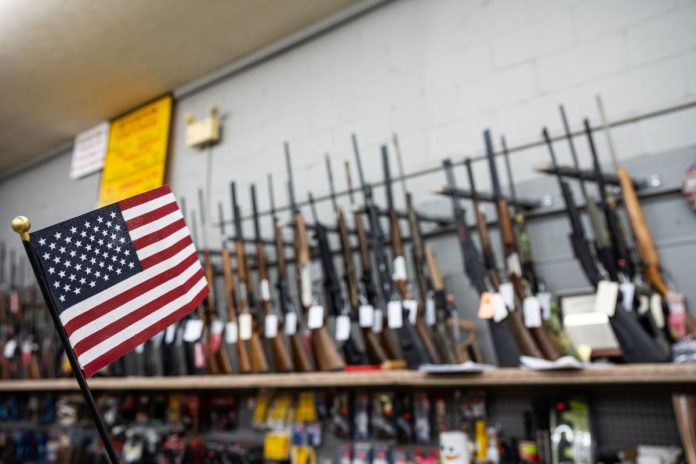By Dan Prud’homme
We need more investment in two types of technologies that could dramatically reduce gun violence in America: better non-lethal arms and a disruptive technology that can disarm illegally used firearms.
As the recent school shooting in Ulvade, Texas has grimly reminded us, the US continues to be unable to prevent murders by civilians armed with guns. Gun violence is nothing short of an epidemic in the US. In 2020 alone, nearly eight-in-ten (79 per cent) of US murders – the deaths of 19,384 people – involved a gun.[1] That is more than four times the number of US troops killed during the entirety of the recent Iraq war.[2]
In terms of gun regulation, anything short of an adapted version of the UK’s strict approach is unlikely to drastically reduce the violence.[3] Yet such strict regulation is not politically practical in the US. And there is a mixed record of success of the limited regulation of guns that is politically feasible in US states.[4] Gun advocates frequently point to this as support for their cause.[5] Even proposals to integrate “smart” gun technology (e.g., fingerprint or radio frequency identification required to enable a gun to fire) seem both politically and logistically challenging to institute and unlikely to truly eliminate gun violence.[6] After all, ensuring that a legitimate owner of a gun is the one firing it is often only part of the problem. The recent shootings in Uvalde, Texas, for example, were committed by an individual who legally purchased his own guns.[7]
This, of course, does not mean that there should not be more experimentation with reasonable regulatory proposals meant to curb gun crime. There should be. However, none of the approaches sufficiently address the root causes of gun violence in America: (1) most firearms (i.e., guns from which a projectile is fired via ignited gunpowder) are lethal, meaning that they can easily kill; and (2) an unfortunate number of people will continue to use firearms, in whatever form they can be obtained, to kill. Any serious solution to gun violence in America needs to strike at the heart of these two issues.
Disruptive innovation can offer us a compelling solution in this regard. Specifically, greater investment and more creative efforts from engineers and scientists are needed to produce better non-lethal arms technology and a disruptive technology that can disarm illegally used firearms.
Investing in better non-lethal arms
Let us start with non-lethal arms. Some activists argue that if more people have firearms, this will deter, or at least allow quicker responses that will prevent, firearm violence. Firearms will always exist in the US anyway, they argue. In my view, a problem with this argument is not that it is entirely logically unsound. Rather, it is the assumption that firearms, which are lethal, are absolutely needed to achieve these outcomes in the future.
If built right, non-lethal arms should be able to strongly deter and prevent deaths from illegal aggression, whether at the hands of individuals with firearms, home-made bombs, knives, or bare fists. Meanwhile, non-lethal arms create far fewer moral and legal repercussions than firearms. As such, not only can they deter and otherwise prevent firearm violence, but people will also be more likely to adopt these methods of protection, assuming that they are made to the right specs.
Because of this, much more should be done to ensure that Americans can be readily defended with effective, affordable, and convenient-to-use non-lethal arms. More innovation and scale is needed from businesses in this space. Perhaps these firearm alternatives will be lasers meant to induce visual impairment or otherwise temporarily disable; plasma weapons; improved directed-energy weapons (so-called “microwave guns”), such as the Active Denial System (ADS) already developed by the US military and used by the Los Angeles police department to control the incarcerated; long-range acoustic devices; long-range (e.g., 100 feet) and multiple-round electroshock weapons and ammunition (such as taser bullets); or a variation on “bean-bag” rounds or rubber bullets. The technologies may be handheld or affixable to drones or other devices. Recent innovations from Axon (formerly TASER International), Harkind Dynamics, QinetiQ, O.F. Mossberg & Sons Inc., and Stellar Photonics offer some interesting examples of what these technologies might look like.[8]
Whatever their form, the key will be to ensure that these arms are able to disable an aggressor extremely effectively, yet just temporarily. Governments should facilitate the growth of this industry while developing necessary regulations regarding when usage of these weapons would be illegal. The police and military should be able to defend themselves and otherwise keep the peace with these alternative, non-lethal arms. Regular citizens should also be able to purchase these arms.
Meanwhile, individual Americans would of course be able to continue to own and use firearms, subject to local regulations. Firearms would continue to be kept at home, used to hunt and shoot targets, and so on. The difference would be that individuals with firearms would be less able to successfully kill innocent people because they would face a high likelihood of first being disabled – in a non-lethal way – by improved non-lethal weapons. Again, this should deter people from even trying to physically harm others in the first place.
To be clear, under this proposal, the US military would of course continue to have access to firearms to fight battles overseas. And these would, of course, join their other weapons for war (e.g., tanks, missiles, and so on) to which regular US citizens and even local police already do not have access.
Investing in firearm-disarming technology
Let us now consider the other part of the proposed solution: firearm-disarming technology. Firearms work as follows. A bullet is loaded into the rear of a barrel, which is a tube connected to a firing pin. The trigger releases a firing pin which strikes an explosive charge in the base of the bullet. The explosion ignites gunpowder which is contained in the shell-casing of the bullet. The resulting pressure forces the bullet out of the gun. Far too often, that bullet, or subsequent bullets, then enters the body of a victim, killing him or her.
Admittedly, we currently know little about how a firearm-disarming technology might look. At a minimum, rather than having to be built into firearms – which obviously is impractical to do for the hundreds of millions of firearms already circulating in the US – the technology should be external. Perhaps it will be wearable. Perhaps it will be used by drones or robots. Perhaps it can be securely affixed in homes, schools, stores, public squares, parks, on streets, and elsewhere.
Perhaps the technology will be based on some variation of magnetic resonance technology. An unexpected incident at an outpatient imaging centre in New York – where a Colt .45 handgun was literally sucked off the hip of its owner into the magnet bore of an MRI machine and discharged – indicates that this might be an avenue worth researching.[9] Perhaps the technology will be a directed-energy weapon that forces a safe “cooking off” of an active shooter’s firearm.[10] Perhaps the technology will instead focus on immediately disabling the body of an active human shooter, similar to the non-lethal weaponry previously mentioned.
Sceptics should know that I am not suggesting that developing firearm-disarming technology, let alone scaling and rolling it out, will be easy. But I find it surprising that there is no serious discussion in the US about this. I find it very hard to believe that a nation that was the first to arrive on the moon, has developed the Internet, and more recently developed CRISPER technology is unable to come up with an effective and scalable technology to disarm firearms. US engineers and scientists, in partnership with businesses and government, have literally revolutionised our world in countless ways that seemed impossible just a few years prior to their discoveries. Is it so unfathomable to think that we could also develop an effective firearm-disarming technology within the next decade or two?
Creatively destroying firearm violence
I believe that the main culprit for the failure to disrupt firearms technology in America is not necessarily guns-rights activism, rather it is due in no small part to a lack of vision and lack of the right incentives. Businesses have an important role to play here. Hopefully a discussion will soon start about developing the types of technologies discussed in this article. In terms of creating the right incentives, firms (including but not limited to incumbent weapons manufacturers) and universities could, of course, go at the R&D alone, hoping for their own success. Perhaps even better, though, they could collaborate. Venture capitalist and other investors could set up funds explicitly designated for the technologies. Large prizes for development of successful tech could be established by non-profits.
Governments would play a role at some point. The Department of Defense (DOD)’s Non-Lethal Weapons Program could get involved in early-stage R&D and prototyping of the technologies, as they already have for ADS.[11] The US Defense Advanced Research Projects Agency (DARPA) in DOD, among other government offices, could get involved as well, for example in funding early-stage research or at least refined applications and scaling of the technologies once developed. And after the technologies are developed, tested, and certified, local governments in US states could decide if they want to procure them and how to best roll them out in their localities. The tech should also be available to citizens for personal use.
To be clear, my proposal, while radical, helps address both the roots of gun violence as well as typical criticisms of past gun reforms in the US by gun-rights proponents. Regarding gun rights, I believe that the US constitution provides myself and other citizens the right to bear arms. My proposal certainly does not undermine this. Regarding the right to defend oneself with arms, my proposal strongly supports this. In fact, it actively facilitates people’s ability to do this more easily than in the past and with fewer moral and legal repercussions. In short, I am proposing that all Americans should be able to keep their legally owned firearms and purchase new ones, while more Americans should be afforded access to improved non-lethal weapons and other technology to effectively protect themselves against individuals illegally using firearms.
Think of the incredible social benefits that better non-lethal arms technology and tech that effectively disarms firearms could have. They could dramatically reduce murders carried out with firearms in the US and overseas. This could literally save tens of thousands, if not hundreds of thousands, of lives every year.
Meanwhile, while the risk of innovation failure will be high, the payoffs for successful businesses seem tremendous. And not only for the proprietors of the end-product technologies, but also for those in upstream and downstream industrial segments supporting the scaling and roll-out of the tech. Further, spillovers would span a range of industries. In short, if successful in developing and diffusing these technologies, rather than destroying more lives, we will creatively destroy firearm violence.
This article was originally published on 12 July 2022.
About the Author
Dan Prud’homme is a senior researcher at the GLORAD Center for Global R&D and Innovation.
References
- Gramlich, J., 2022. “What the data says about gun deaths in the US”. Pew Research Center, available at https://www.pewresearch.org/fact-tank/2022/02/03/what-the-data-says-about-gun-deaths-in-the-u-s/
- USDOD, 2022. US Department of Defense Casualty Status. Available at https://www.defense.gov/casualty.pdf
- Lopez, G., 2018. “How gun control works in America, compared with 4 other rich countries”. Vox, available at https://www.vox.com/policy-and-politics/2015/12/4/9850572/gun-control-us-japan-switzerland-uk-canada
- RAND, 2020. “What science tells us about the effects of gun policies”. RAND, available at https://www.rand.org/research/gun-policy/key-findings/what-science-tells-us-about-the-effects-of-gun-policies.html
- NDR-ILA (undated). “Why gun control doesn’t work”. National Rifle Association-Institute for Legislative Action, available at https://www.nraila.org/why-gun-control-doesn-t-work/>
- Dolan, R., 2016. “Gun manufacturers need to lead change, not just follow the law”. Harvard Business Review, available at https://hbr.org/2016/03/gun-manufacturers-need-to-lead-change-not-just-follow-the-law
- Oxner, R., 2022. “Uvalde gunman legally bought AR rifles days before shooting, law enforcement says”. Texas Tribune, available at https://www.texastribune.org/2022/05/25/uvalde-shooter-bought-gun-legally/
- Hambling, D., 2020. “Pentagon’s non-lethal SPECER could be a game changer for crowd control”. Forbes, available at https://www.forbes.com/sites/davidhambling/2020/07/14/pentagons-new-non-lethal-specter-is-a-game-changer-for–crowd-control/?sh=7f0ddc575316; Brahambhatt, R., 2021. “Future weapons: Microwave weapons”. ZME Science, available at https://www.zmescience.com/other/feature-post/future-weapons-microwave-22112021/; Nye, L., 2022. “The 8 most painful non-lethal weapons”. We Are The Mighty, available at https://www.wearethemighty.com/lists/8-painful-nonlethal-weapons/; Ackerman, S., 2012. Video: “I got blasted by the Pentagon’s pain ray – Twice”. Wired, available at https://www.wired.com/2012/03/pain-ray-shot/; Houser, K., 2018. “The US has invented a non-lethal weapon that uses lasers to scream, flash, and burn through clothing”. Business Insider, available at https://www.businessinsider.com/a-new-military-device-uses-lasers-to-scream-flash-and-burn-clothes-2018-3#:~:text=The%20Joint%20Non%2DLethal%20Weapons,and%20can%20burn%20through%20clothing; POL, 2008. “TASER and Mossberg to produce dedicated less-lethal shotgun”. PoliceMag, available at https://www.policemag.com/344075/taser-and-mossberg-to-produce-dedicated-less-lethal-shotgun; Gallagher, S., 2018. “Non-lethal weapon: DOD seeks to use lasers to create shouting will-o-the-wisp”. ARSTechnica, available at https://arstechnica.com/tech-policy/2018/03/non-lethal-weapon-dod-seeks-to-use-lasers-to-create-shouting-will-o-the-wisp/; Knight, W., 2005. “US military sets laser PHASRs to stun”. New Scientist, available at https://www.newscientist.com/article/dn8275-us-military-sets-laser-phasrs-to-stun/; Brewster, R., 2021. Taser founder and CEO says police won’t need guns in ten years. Forbes, available at https://www.forbes.com/sites/thomasbrewster/2021/04/14/mistaking-a-taser-for-a-gun-20-billion-non-lethal-weapons-giant-axon-thinks-it-can-replace-the-police-pistol-for-good/?sh=620f10891b78
- Beitia, A., Meyers, S., Kanal, E., Bartell, W., 2002. “Spontaneous discharge of a firearm in an MR imaging environment”. American Journal of Roentgenology, 178: 1092-1094, available at https://www.ajronline.org/doi/10.2214/ajr.178.5.1781092
- Telles, R., Neto, F., Guedes, R., Loiola, B., 2021. “Cook-off evaluation in gun barrels through a transient heat transfer analysis”. 26th International Congress of Mechanical Engineering COBEM.
- See the website of DOD’s JIFCO Non-Lethal Weapons Program here: https://jnlwp.defense.gov/Contact.aspx




































































